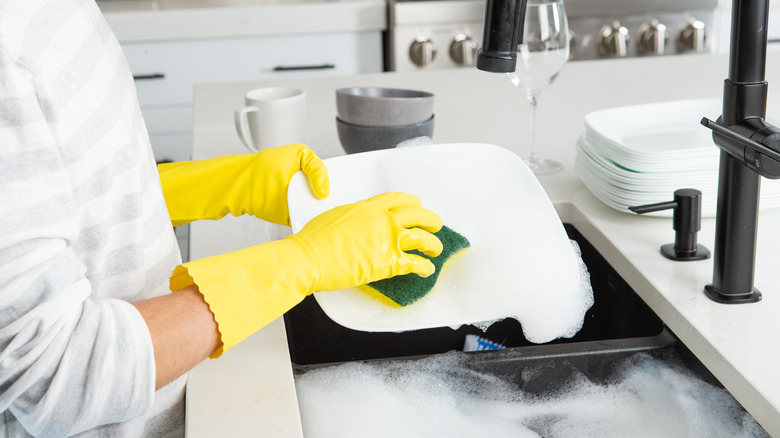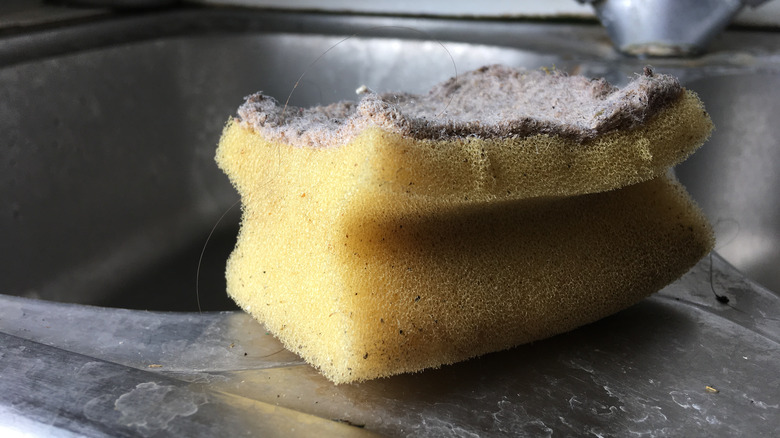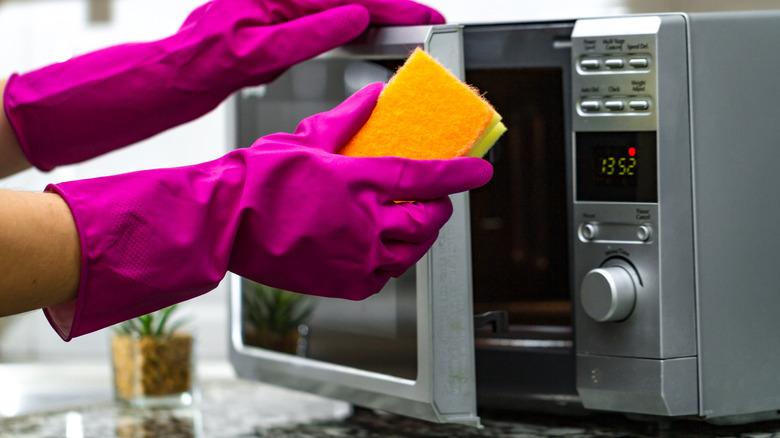How To Tell It's Time To Throw Out The Kitchen Sponge
Even though your kitchen sponge is always covered in dish soap, it's the perfect home for growing bacteria. If fact, it's recommended to throw away your sponge and replace it with a brand-new one at least every week. This is around the time that it'll start smelling and feeling slimy. That said, you can stretch its life out to two weeks by regularly sanitizing it in your microwave or dishwasher. You don't want to keep a kitchen sponge any longer, or you increase your risk of foodborne illness and cross-contamination.
When you wash a dish, food particles become lodged inside, feeding the microorganisms. Plus, kitchen sponges stay moist long after you're done using them, and they're covered in small crevices. When you combine all these factors, E. coli, salmonella, and 360 other kinds of bacteria can grow on your kitchen sponge, according to a study from 2017. While these germs aren't all harmful pathogens, it's better to keep a clean sponge than risk getting sick from a dirty one, Trina McMahon, Ph.D., a microbiologist and professor at the University of Wisconsin–Madison, told Epicurious.
Using dish soap and hot water isn't enough to wash them. In fact, warmer water will create an even better environment for bacteria to multiply. The best way to keep your family safe from potential pathogens is by knowing when it's time to throw away your kitchen sponge.
If it looks dirty or has a bad smell
There are many signs to look out for in your kitchen sponge that tell you it's time to get a new one. You'll need to use your hands, eyes, and nose to decide if it should go in the garbage. First, look at your sponge to see if it's dirty. If you can't decide if it's dirty enough to get rid of, you should smell it. Kitchen sponges have a sour odor, similar to mildew. This happens because of the bacteria. Pay attention to how it feels in your hand as your washing dishes. Over time, sponges can become slimy from the bacteria and food particles inside them. You must throw away your sponge if you notice one or all of these signs.
Markus Egert, Ph.D., professor of microbiology and hygiene at Furtwangen University, has an easier way to decipher when you're past due for a new sponge. Just look at the calendar. If you've been using the same one for one to two weeks, it's time to get a new one, he told The Healthy. Replacing them so frequently may seem like a waste, but it'll protect you and your family from foodborne illnesses. You can make it easier to stay on top of using new ones by purchasing a large pack of cheap sponges to keep in your kitchen.
Sanitize your sponge to give it a longer life
There are ways to clean your kitchen sponges so you don't have to replace them as frequently. The key is to kill the bacteria growing inside them by sanitizing them. The method you choose depends on what appliances you have available to use. The best option is a dishwasher. It'll kill 99.9% of the bacteria in a kitchen sponge, Marla Mock, president of Molly Maid, told TODAY. All you have to do is place it on the rack along with your dirty dishes and run the cycle with the heated dry feature on.
Another way to kill bacteria is in your microwave. First, soak your sponge in hot, soapy water. Then microwave it for two minutes. You have to be careful when doing this because a fire can start if your sponge isn't completely wet. Another caveat to this option is that it isn't as reliable at killing 99.9% of germs as the dishwasher is. This is because microwaves are available in different strengths, and sponges come in different sizes.
Lastly, you can sanitize it with a bleach solution. Fill a container with one quart of warm water and ½ a teaspoon of bleach. Then place your sponge inside and make sure it's completely soaked. After a minute, you can remove it and get back to washing dishes.


